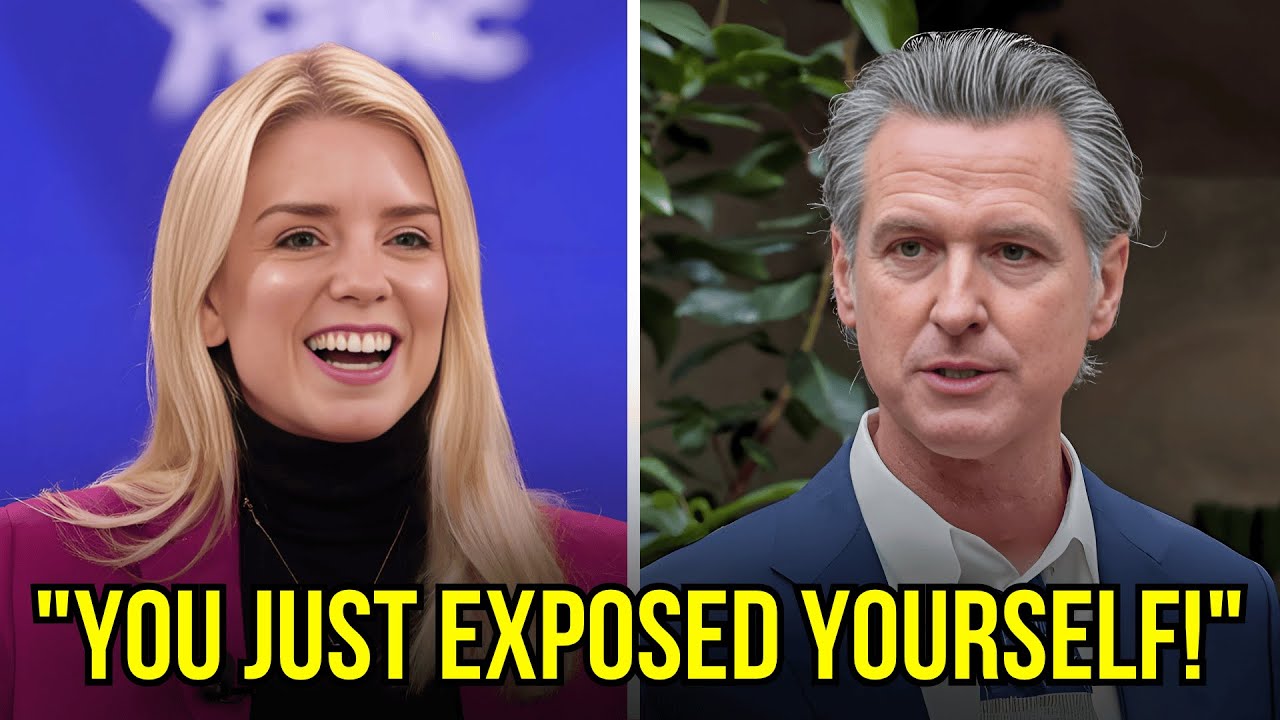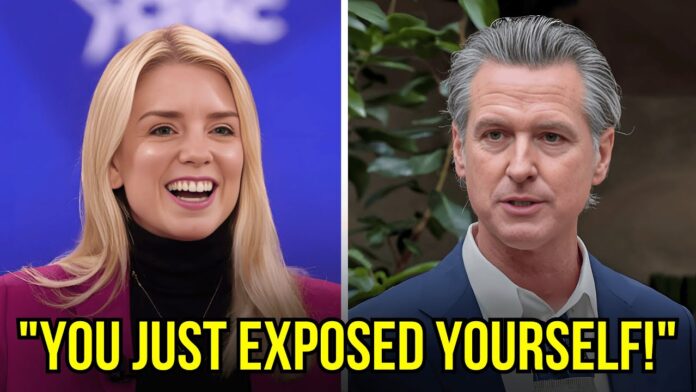😱 Gavin Newsom LAUGHS at Pam Bondi in Congress… but her SHOCKING comeback left him FROZEN on stage! 😲 What did she say to silence him? This viral moment is blowing up! 👉

matically, leaving Newsom visibly stunned. Posts on platforms like X and TikTok have amplified the moment, with hashtags like #CongressClash and #NewsomFrozen trending briefly.
Gavin Newsom, a prominent Democratic figure and potential presidential contender, has long been a lightning rod for both admiration and criticism. His policies on immigration, crime, and economic management have drawn scrutiny, particularly from conservative critics who argue he prioritizes optics over substance. Pam Bondi, meanwhile, is a formidable figure in Republican circles, known for her tenure as Florida’s Attorney General and her fierce advocacy on issues like crime and national security. The clash between these two high-profile figures was primed for virality, given their contrasting ideologies and the charged political climate of 2025.
While the exact topic of their exchange remains unclear, sources suggest it may have centered on California’s handling of crime, economic policy, or immigration—issues where Newsom and Bondi hold starkly opposing views. One report claims Bondi called Newsom’s excuses “pathetic,” escalating the confrontation into a defining moment. The lack of a full transcript or verified video makes it challenging to confirm the specifics, but the narrative of Newsom’s laughter followed by Bondi’s cutting response has struck a chord with audiences.
Why the Moment Went Viral
The viral appeal of this moment lies in its dramatic arc: a confident governor laughing, only to be humbled by a sharp-witted opponent. This narrative resonates with audiences across the political spectrum, tapping into universal themes of hubris and accountability. For conservatives, Bondi’s retort represents a triumph over what they see as Newsom’s smugness, while progressives view it as a moment of unfair targeting. The phrase “left him FROZEN on stage” evokes vivid imagery, amplifying the emotional impact and making it ripe for social media sharing.
Social media platforms like X and TikTok have played a central role in spreading the story. A TikTok video from user @user7260256751433 garnered significant attention, describing the exchange as a “must-see moment” with hashtags like #PoliticalDrama and #ViralMoment. Similarly, YouTube channels have capitalized on the buzz, with one video titled “Gavin Newsom LAUGHS at Pam Bondi in Congress — Her Next Words Leave Him FROZEN on Stage” premiering on August 8, 2025. These platforms thrive on emotionally charged content, and a 2020 MIT study confirms that anger and surprise drive higher engagement online, explaining why this moment spread so quickly.
The clash also benefits from the star power of its protagonists. Newsom’s charisma and Bondi’s tenacity make them compelling figures, and their confrontation fits neatly into the culture war narrative that dominates modern politics. A 2023 Pew Research Center poll found that 62% of Americans view political discourse as increasingly divisive, and moments like this fuel that perception by pitting ideological opposites against each other in a public arena.
The Broader Issue of Political Rhetoric
The Newsom-Bondi exchange highlights a critical issue in American politics: the role of rhetoric in shaping public opinion. Newsom’s laughter, whether intentional or spontaneous, was perceived by some as dismissive or arrogant, setting the stage for Bondi’s comeback to resonate as a defense of truth or accountability. Political rhetoric often walks a fine line between persuasion and provocation, and this moment illustrates how quickly a misstep can shift the narrative.
Rhetoric in politics is not just about words; it’s about power. Newsom’s laugh could be interpreted as an attempt to downplay Bondi’s critique, a tactic often used to deflect serious challenges. Bondi’s response, described as “searing” and “brutal” in some reports, flipped the script, using sharp language to reclaim authority. According to a 2021 study in the Journal of Communication, emotionally charged rhetoric is more likely to influence audiences, as it taps into psychological triggers like anger or moral outrage. Bondi’s ability to leave Newsom “frozen” suggests she mastered this dynamic, turning a moment of levity into a serious rebuke.
However, the reliance on such confrontational rhetoric has downsides. It risks deepening polarization, as supporters of each figure rally to their side without seeking common ground. The same study notes that divisive language can erode trust in institutions, as voters become more cynical about leaders’ intentions. In this case, the viral framing of the exchange—emphasizing drama over substance—may overshadow the policy issues at stake, such as crime rates or economic policy, which deserve nuanced discussion.
Implications for Newsom and Bondi
For Gavin Newsom, this moment could have both short-term and long-term consequences. In the short term, it risks damaging his carefully curated image as a composed, forward-thinking leader. Being portrayed as “frozen” or humiliated on a national stage could weaken his appeal, especially if he harbors ambitions for higher office. A 2022 Gallup poll found that 53% of voters prioritize likability in political candidates, and moments of perceived weakness can linger in the public’s memory.
For Pam Bondi, the exchange bolsters her reputation as a fierce conservative advocate. Her ability to deliver a “career-ending blow,” as some sources claim, strengthens her standing among Republican voters and could position her for a larger role in national politics. However, Bondi also faces challenges, as other reports suggest she’s under scrutiny for unrelated controversies, such as her handling of the Epstein files, which could temper the positive attention from this moment.
The Role of Social Media and Media Literacy
The viral spread of this story underscores the power of social media to shape narratives, often at the expense of context. Platforms like X amplify soundbites, reducing complex debates to memorable quips. A 2021 USC study found that false or misleading information spreads six times faster than accurate content online, and the lack of a full video or transcript for this exchange leaves room for speculation and distortion. Users on X have shared conflicting interpretations, with some praising Bondi’s boldness and others accusing her of grandstanding.
This dynamic highlights the need for media literacy. Voters must approach viral moments with skepticism, seeking primary sources to verify claims. Fact-checking organizations like PolitiFact can help, but individuals also bear responsibility for questioning sensational headlines. The Newsom-Bondi clash, while compelling, risks becoming a distraction from substantive policy discussions if left uncontextualized.
Toward a More Constructive Discourse
To move beyond divisive moments like this, political leaders and the public must prioritize constructive dialogue. For Newsom and Bondi, this means focusing on policy substance over personal attacks. Newsom could address criticisms of California’s policies with data-driven arguments, while Bondi could clarify her critiques without resorting to inflammatory rhetoric. A 2019 study in the Journal of Social and Personal Relationships suggests that transparency and accountability reduce perceptions of deceit, a lesson both figures could apply.
Voters, too, have a role to play. By demanding nuance and rewarding leaders who engage in good-faith debate, the public can shift the incentives away from viral confrontations. Media outlets and social platforms should also prioritize context, providing links to full videos or transcripts to counter misinformation.
Conclusion
The Gavin Newsom-Pam Bondi clash is more than a viral moment; it’s a window into the state of American political discourse. It reveals the power of rhetoric to captivate audiences, the risks of polarization, and the challenges of navigating truth in a digital age. While Bondi’s retort may have left Newsom “frozen,” the real challenge lies in moving beyond such moments to address the issues—crime, economy, immigration—that sparked the exchange in the first place.
As the story continues to unfold, voters must seek out the full context and hold leaders accountable for substance, not just style. For now, this viral confrontation serves as a reminder that in politics, words matter—and so does the truth behind them. To learn more about this explosive moment, visit [link to external resource].
